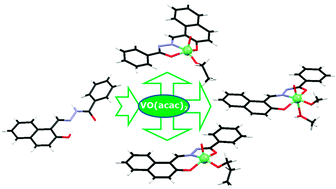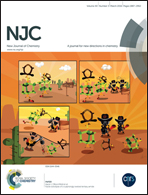Antimicrobial activity of aroylhydrazone-based oxido vanadium(v) complexes: in vitro and in silico studies†
Abstract
A tridentate Schiff base ligand (E)-N′-((2-hydroxynaphthalen-1-yl)methylene)benzohydrazide (H2L) and its oxido-vanadium(V) complexes with formulae [VO(L)(MeOH)(OMe)] (1), [VO(L)(OEt)] (2), and [VO(L)(OPr)] (3) have been synthesized and fully characterized by physicochemical and spectroscopic methods including elemental analysis, FT-IR, 1H NMR and molar conductivity. The solid state structures of H2L and complexes 1–3 have also been investigated using single crystal X-ray analysis. It was concluded that H2L crystallized in keto form in the solid state; however in all complexes, the ligand appears in the enol form. The coordination geometry of complex 1 was found to be distorted octahedral while complexes 2 and 3 adopt square pyramidal geometries. The antimicrobial activity of these compounds was also evaluated against Escherichia coli (ATCC 25922) and Staphylococcus aureus (ATCC 33591 and 29213) bacteria and the results showed that all three complexes have significant antibacterial activities. In order to determine the potential of these complexes as antimicrobial agents, molecular docking of the complexes with GlcN-6-P synthase was also investigated.



 Please wait while we load your content...
Please wait while we load your content...